Benedicts test - Study guides, Revision notes & Summaries
Looking for the best study guides, study notes and summaries about Benedicts test? On this page you'll find 116 study documents about Benedicts test.
Page 3 out of 116 results
Sort by
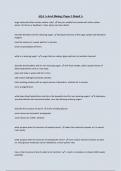
-
AQA A-level Biology Paper 1 Rated A
- Exam (elaborations) • 19 pages • 2024
-
- £9.99
- + learn more
AQA A-level Biology Paper 1 Rated A large molecules often contain carbon. why? they can readily form bonds with other carbon atoms. this forms a 'backbone'. other atoms can then attach. describe benedicts test for reducing sugars reagent. add equal volumes of the sugar sample and benedicts heat the mixture in a water bath for 5 minutes. brick red precipitate will form. what is a reducing sugar? a sugar that can reduce (give electrons to) another chemical. describe the ...
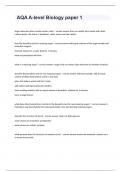
-
AQA A-level Biology paper 1 Question With 100%Varified Answers.
- Exam (elaborations) • 20 pages • 2024
- Available in package deal
-
- £9.99
- + learn more
large molecules often contain carbon. why? - correct answer they can readily form bonds with other carbon atoms. this forms a 'backbone'. other atoms can then attach. describe benedicts test for reducing sugars - correct answer add equal volumes of the sugar sample and benedicts reagent. heat the mixture in a water bath for 5 minutes. brick red precipitate will form. what is a reducing sugar? - correct answer a sugar that can reduce (give electrons to) another chemical. describe the...
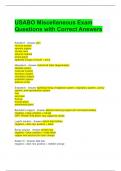
-
USABO Miscellaneous Exam Questions with Correct Answers
- Exam (elaborations) • 6 pages • 2024
-
- £9.99
- + learn more
USABO Miscellaneous Exam Questions with Correct Answers Ectoderm - Answer-skin nervous system sensory organs cornea, lens adrenal medulla pineal gland epithelial linings of mouth + anus Mesoderm - Answer-notochord (later degenerates) skeletal system muscular system excretory system circulatory system lymphatic system adrenal cortex Endoderm - Answer-epithelial lining of digestive system, respiratory system, urainry system, and reproductive system liver pancreas thymus t...
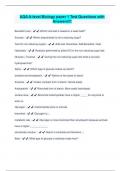
-
AQA A-level Biology paper 1 Test Questions with Answers!!!
- Exam (elaborations) • 22 pages • 2024
-
- £9.19
- + learn more
AQA A-level Biology paper 1 Test Questions with Answers!!! Benedict's test - ️️ -Which food test is heated in a water bath? Sucrose - ️️ -Which disaccharide is not a reducing sugar? Test for non-reducing sugars - ️️ -Add acid. Neutralise. Add Benedicts. Heat. Hydrolysis - ️️ -Reaction performed by dilute HCl in the non reducing sugar test. Glucose + fructose - ️️ -During the non-reducing sugar test what is sucrose hydrolysed into? Alpha - ️️ -Which type of glucos...
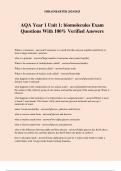
-
AQA Year 1 Unit 1: biomolecules Exam Questions With 100% Verified Answers
- Exam (elaborations) • 8 pages • 2024
-
- £8.07
- + learn more
©BRAINBARTER 2024/2025 AQA Year 1 Unit 1: biomolecules Exam Questions With 100% Verified Answers What is a monomer - answerA monomer is a small unit that can join together repetitively to form a larger molecule / polymer. what is a polymer - answerlarge number of monomer units joined together What is the monomer of carbohydrates called? - answermonosaccharides What is the monomer of protein called? - answeramino acids What is the monomer of nucleic acids called? - answernucleotide what...
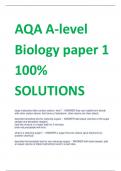
-
AQA A-level Biology paper 1 100% SOLUTIONS
- Exam (elaborations) • 15 pages • 2023
-
- £7.69
- + learn more
large molecules often contain carbon. why? - ANSWER they can readily form bonds with other carbon atoms. this forms a 'backbone'. other atoms can then attach. describe benedicts test for reducing sugars - ANSWER add equal volumes of the sugar sample and benedicts reagent. heat the mixture in a water bath for 5 minutes. brick red precipitate will form. what is a reducing sugar? - ANSWER a sugar that can reduce (give electrons to) another chemical. describe the benedicts test for non ...
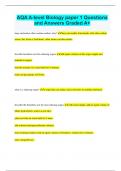
-
AQA A-level Biology paper 1 Questions and Answers Graded A+
- Exam (elaborations) • 33 pages • 2024
- Available in package deal
-
- £8.99
- + learn more
large molecules often contain carbon. why? they can readily form bonds with other carbon atoms. this forms a 'backbone'. other atoms can then attach. describe benedicts test for reducing sugars add equal volumes of the sugar sample and benedicts reagent. heat the mixture in a water bath for 5 minutes. brick red precipitate will form. what is a reducing sugar? a sugar that can reduce (give electrons to) another chemical. describe the benedicts test for non reducing sugars with food sam...
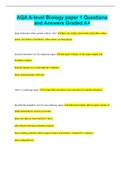
-
AQA A-level Biology paper 1 Questions and Answers Graded A+
- Exam (elaborations) • 33 pages • 2023
- Available in package deal
-
- £7.69
- + learn more
AQA A-level Biology paper 1 Questions and Answers Graded A+ large molecules often contain carbon. why? they can readily form bonds with other carbon atoms. this forms a 'backbone'. other atoms can then attach. describe benedicts test for reducing sugars add equal volumes of the sugar sample and benedicts reagent. heat the mixture in a water bath for 5 minutes. brick red precipitate will form. what is a reducing sugar? a sugar that can reduce (give electrons to) another chemical. describe th...
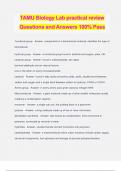
-
TAMU Biology Lab practical review Questions and Answers 100% Pass
- Exam (elaborations) • 13 pages • 2024
- Available in package deal
-
- £9.61
- + learn more
TAMU Biology Lab practical review Questions and Answers 100% Pass functional group - Answer- components of a biochemical molecule, identifies the type of biomolecule hydroxyl group - Answer- a functional group found in alcohols and sugars, polar, OH carbonyl group - Answer- found in carbohydrates, two types terminal aldehyde and an internal ketone one or the other on every monosaccharide carboxyl - Answer- found in fatty acids and amino acids, acidic, double bond between carbon and oxyg...
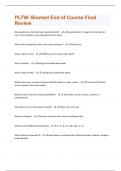
-
PLTW- Biomed End of Course Final Review Questions And Answers 2024 Updates
- Exam (elaborations) • 20 pages • 2024
- Available in package deal
-
- £6.15
- + learn more
How quickly does the body lose heat after death? - Approximately 1.5 degrees Fahrenheit per hour until it reaches surrounding environment temp Who did the fingerprint at the crime scene belong to? - Alex Garcia What is rigor mortis? - stiffening of the muscles after death What is lividity? - Pooling of the blood after death What is algor mortis? - Cooling of the body after death What causes your muscles to become stiff after death, or rigor mortis? - The loss of ATP which lasts for about ...

How much did you already spend on Stuvia? Imagine there are plenty more of you out there paying for study notes, but this time YOU are the seller. Ka-ching! Discover all about earning on Stuvia


